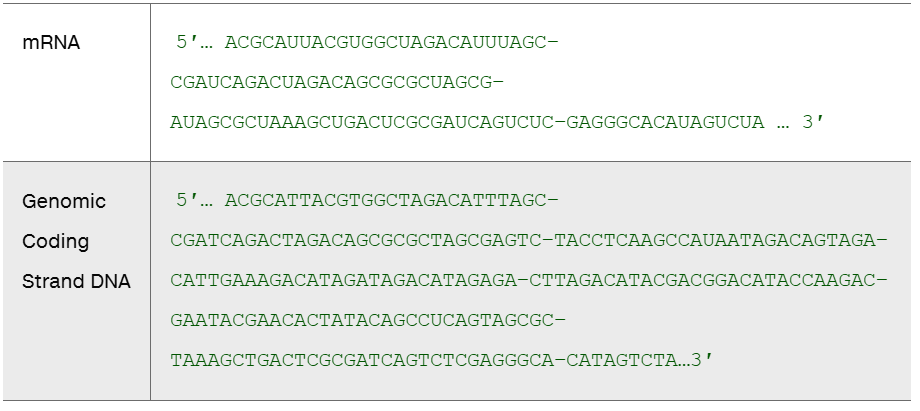One form of posttranscriptional modification of most eukaryotic pre-mRNAs is the addition of a poly-A sequence at the 3' end. The absence of a poly-A sequence leads to rapid degradation of the transcript. Poly-A sequences of various lengths are also added to many bacterial RNA transcripts where, instead of promoting stability, they enhance degradation. In both cases, RNA secondary structures, stabilizing proteins, or degrading enzymes interact with poly-A sequences. Considering the activities of RNAs, what might be general functions of 3'-polyadenylation?
Table of contents
- 1. Introduction to Genetics51m
- 2. Mendel's Laws of Inheritance3h 37m
- 3. Extensions to Mendelian Inheritance2h 41m
- 4. Genetic Mapping and Linkage2h 28m
- 5. Genetics of Bacteria and Viruses1h 21m
- 6. Chromosomal Variation1h 48m
- 7. DNA and Chromosome Structure56m
- 8. DNA Replication1h 10m
- 9. Mitosis and Meiosis1h 34m
- 10. Transcription1h 0m
- 11. Translation58m
- 12. Gene Regulation in Prokaryotes1h 19m
- 13. Gene Regulation in Eukaryotes44m
- 14. Genetic Control of Development44m
- 15. Genomes and Genomics1h 50m
- 16. Transposable Elements47m
- 17. Mutation, Repair, and Recombination1h 6m
- 18. Molecular Genetic Tools19m
- 19. Cancer Genetics29m
- 20. Quantitative Genetics1h 26m
- 21. Population Genetics50m
- 22. Evolutionary Genetics29m
10. Transcription
RNA Modification and Processing
Problem 31b
Textbook Question
A portion of a human gene is isolated from the genome and sequenced. The corresponding segment of mRNA is isolated from the cytoplasm of human cells, and it is also sequenced. The nucleic acid strings shown here are from genomic coding strand DNA and the corresponding mRNA.

Does this intron contain normal splice-site sequences?
 Verified step by step guidance
Verified step by step guidance1
Step 1: Understand the problem. The question asks whether the intron in the genomic DNA contains normal splice-site sequences. Splice sites are specific sequences at the boundaries of introns and exons that are recognized by the spliceosome during RNA splicing. The canonical splice-site sequences are typically 'GU' at the 5' end of the intron and 'AG' at the 3' end of the intron.
Step 2: Identify the intron region in the genomic DNA sequence. Introns are non-coding regions that are removed during RNA splicing. Compare the genomic DNA sequence with the mRNA sequence to locate the intron, as the mRNA sequence will only contain exons (coding regions).
Step 3: Examine the 5' and 3' ends of the intron in the genomic DNA sequence. Look for the presence of the canonical splice-site sequences ('GU' at the 5' end and 'AG' at the 3' end). These sequences are critical for proper splicing.
Step 4: Analyze the surrounding sequences for additional splice-site consensus motifs. Besides the 'GU' and 'AG' sequences, other conserved regions such as the branch point (usually an 'A' located upstream of the 3' splice site) and polypyrimidine tract (a sequence rich in pyrimidines near the 3' splice site) should also be checked.
Step 5: Conclude whether the intron contains normal splice-site sequences based on the analysis. If the canonical 'GU' and 'AG' sequences, along with other conserved motifs, are present, the intron likely contains normal splice-site sequences. If these sequences are absent or mutated, splicing may be impaired.
 Verified video answer for a similar problem:
Verified video answer for a similar problem:This video solution was recommended by our tutors as helpful for the problem above
Video duration:
2mPlay a video:
Was this helpful?
Key Concepts
Here are the essential concepts you must grasp in order to answer the question correctly.
Introns and Exons
Introns are non-coding sequences of DNA that are transcribed into pre-mRNA but are removed during RNA splicing. Exons, on the other hand, are the coding sequences that remain in the mature mRNA and are translated into proteins. Understanding the distinction between introns and exons is crucial for analyzing gene structure and function.
Recommended video:
Guided course

mRNA Processing
Splice Sites
Splice sites are specific nucleotide sequences at the boundaries of introns and exons that signal where splicing should occur. The consensus sequences at these sites, typically found at the 5' and 3' ends of introns, are recognized by the spliceosome, the complex responsible for removing introns from pre-mRNA. Identifying these sequences is essential for determining if an intron contains normal splice-site sequences.
Recommended video:
Guided course

mRNA Processing
RNA Splicing
RNA splicing is the process by which introns are removed from pre-mRNA and exons are joined together to form mature mRNA. This process is vital for the correct expression of genes, as it ensures that only the coding regions are translated into proteins. Analyzing the splicing process helps in understanding gene regulation and the potential impact of mutations on protein synthesis.
Recommended video:
Related Videos
Related Practice
Textbook Question
543
views



